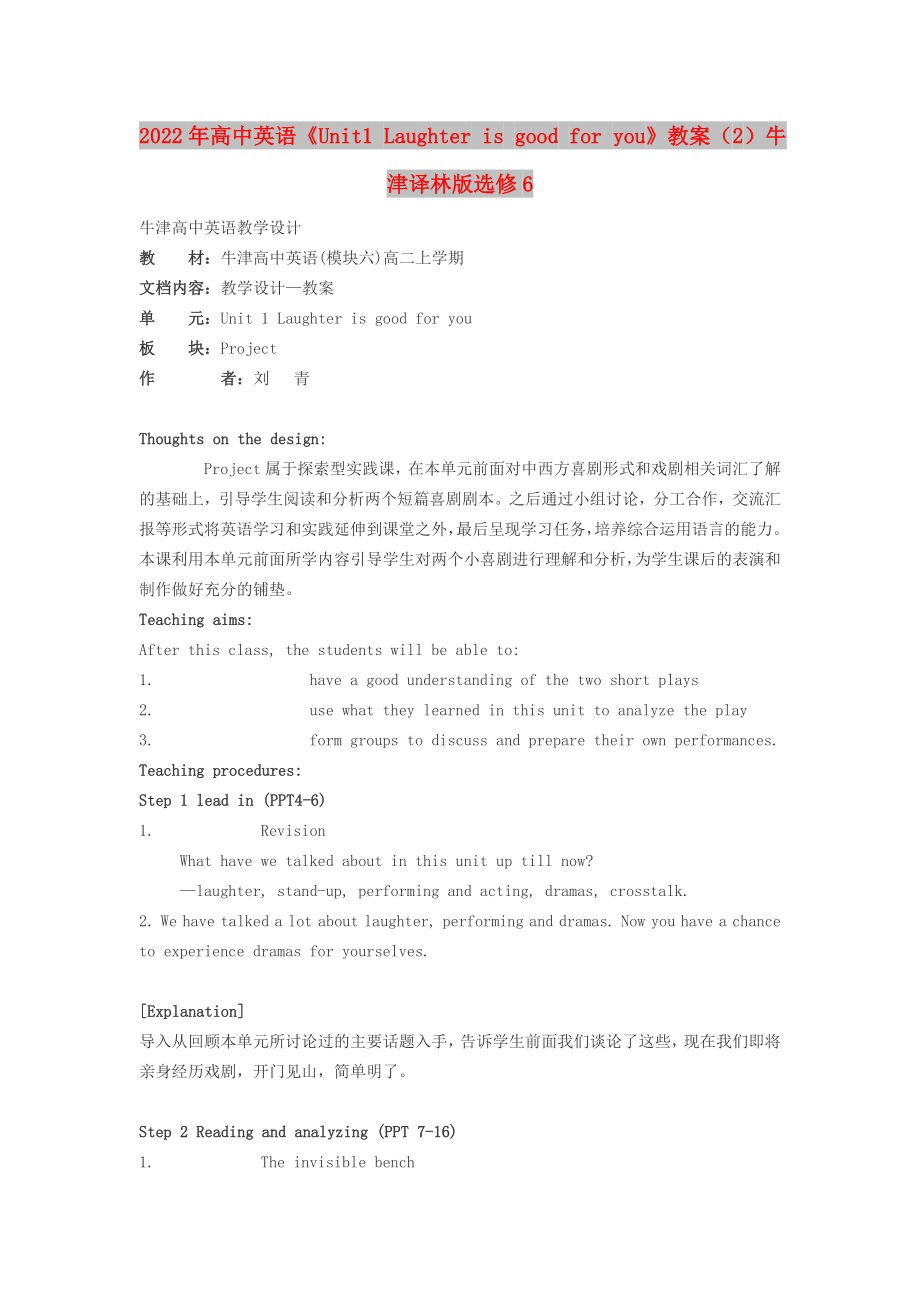《2022年高中英語(yǔ)《Unit1 Laughter is good for you》教案(2)牛津譯林版選修6》由會(huì)員分享�����,可在線閱讀�����,更多相關(guān)《2022年高中英語(yǔ)《Unit1 Laughter is good for you》教案(2)牛津譯林版選修6(3頁(yè)珍藏版)》請(qǐng)?jiān)谘b配圖網(wǎng)上搜索�����。
1、2022年高中英語(yǔ)《Unit1 Laughter is good for you》教案(2)牛津譯林版選修6
牛津高中英語(yǔ)教學(xué)設(shè)計(jì)
教 材:牛津高中英語(yǔ)(模塊六)高二上學(xué)期
文檔內(nèi)容:教學(xué)設(shè)計(jì)—教案
單 元:Unit 1 Laughter is good for you
板 塊:Project
作????者:劉? 青
?
Thoughts on the design:
???? Project屬于探索型實(shí)踐課�����,在本單元前面對(duì)中西方喜劇形式和戲劇相關(guān)詞匯了解的基礎(chǔ)上�����,引導(dǎo)學(xué)生閱讀和分析兩個(gè)短篇喜劇劇本�����。之后通過(guò)小組討論�����,分工合作�����,交流匯報(bào)等形式將英語(yǔ)學(xué)習(xí)和實(shí)踐延伸到課堂之
2�����、外�����,最后呈現(xiàn)學(xué)習(xí)任務(wù),培養(yǎng)綜合運(yùn)用語(yǔ)言的能力�����。本課利用本單元前面所學(xué)內(nèi)容引導(dǎo)學(xué)生對(duì)兩個(gè)小喜劇進(jìn)行理解和分析�����,為學(xué)生課后的表演和制作做好充分的鋪墊�����。
Teaching aims:
After this class, the students will be able to:
1.????????? have a good understanding of the two short plays
2.????????? use what they learned in this unit to analyze the play
3.????????? form groups to dis
3�����、cuss and prepare their own performances.
Teaching procedures:
Step 1 lead in (PPT4-6)
1.?????? Revision
?? What have we talked about in this unit up till now?
?? —laughter, stand-up, performing and acting, dramas, crosstalk.
2. We have talked a lot about laughter, performing and dramas. Now yo
4�����、u have a chance to experience dramas for yourselves.
?
[Explanation]
導(dǎo)入從回顧本單元所討論過(guò)的主要話題入手�����,告訴學(xué)生前面我們談?wù)摿诉@些�����,現(xiàn)在我們即將親身經(jīng)歷戲劇�����,開(kāi)門(mén)見(jiàn)山�����,簡(jiǎn)單明了�����。
?
Step 2 Reading and analyzing (PPT 7-16)
1.?????? The invisible bench
(1)??? Ask the students to read the script and then ask them some questions.
①???? Is there a
5�����、bench in the courtyard?
????? --No
② What does the word “invisible” mean?
--That cannot be seen
③ Is this a edy? Why or why not?
??? ???--Yes. Because actors use body language to perform, which makes the audience laugh with a surprising and amusing ending.
④In which style of stand-up is this p
6�����、lay, observational, prop, physical or impressionist?
--Physical. They use their bodies to make jokes.
(2) After the Ss understand the play well,? ask them: “If we want to put on this short play, what should we prepare?”
????? Script,drector , actors and actresses, stage (lights, microphones).
2.
7�����、?????? The important paper
(1)??? Ask the students to read the script and then ask them some questions
①How many characters are there in the play?
?? --Three. The king, the queen and the servant.
②Who do you think is the main character/ hero in the play?
?? --The king.
③What does the King actu
8、ally want?
?? --Toilet paper.
④Why are the others unable to understand him?
?? --Because he is the king, important paper may mean very important official documents for him.
⑤In what style of stand-up edy is this play?
?? -- Prop—toilet paper and some other papers
physical—“pump into people or
9�����、things”
⑥How does the playwright make the play funny?
????? --The playwright uses a play upon words—important paper and toilet paper—to make people laugh.
(2) After the students understand the play well, ask them: “If we want to put on this short play, what should we prepare?”
???? Script, Direc
10�����、tor, Actors and actresses, Toilet paper & other paper, Throne, Costumes, Stage (lights, microphones, scenery)
?
[Explanation]
這兩個(gè)短劇通俗易懂�����,學(xué)生在理解上問(wèn)題不大�����,因此�����,教師可以結(jié)合喜劇的特點(diǎn)以及Drama表演需要籌備的東西等方面引發(fā)學(xué)生思考�����。一方面能幫助他們進(jìn)一步理解喜劇的各種形式�����,另一方面為他們Project的完成做好準(zhǔn)備�����。而且�����,和Word power的內(nèi)容有機(jī)結(jié)合�����,增加相關(guān)詞匯的復(fù)現(xiàn)�����,便于學(xué)生的接受和記憶�����。
?
Step 3 Planning and
11、 preparing (PPT 15-17)
?1. Ask the students to discuss in groups the following questions, which will help them to carry out the project. Ask them to write down their plans.
????????? Which play do you want to put on
????????? Who will play each character? Who will be the director?
????????? What
12�����、 kind of scenery will need? Who will make it?
????????? Will you need props? Who will find them?
????????? Will you need costumes? Who will make them?
????????? Where and how often will you practice?
? 2. Ask some groups to report them idea about the project. The teacher may give some suggestions in this step.
[Explanation]??? 在分析了兩個(gè)短劇之后�����,讓學(xué)生充分討論來(lái)選擇他們即將演出的短劇�����,用問(wèn)題引導(dǎo)他們思考在演出的前后應(yīng)該籌備和考慮的方面�����,最后的匯報(bào)可以讓老師和學(xué)生相互學(xué)習(xí)和借鑒�����,并且發(fā)現(xiàn)問(wèn)題及時(shí)解決和改進(jìn)�����,以確保課后學(xué)生的任務(wù)更順利的完成�����。
?
Step 4 Homework (PPT 18)
Ask the students to prepare and practice their plays.
 2022年高中英語(yǔ)《Unit1 Laughter is good for you》教案(2)牛津譯林版選修6
2022年高中英語(yǔ)《Unit1 Laughter is good for you》教案(2)牛津譯林版選修6

